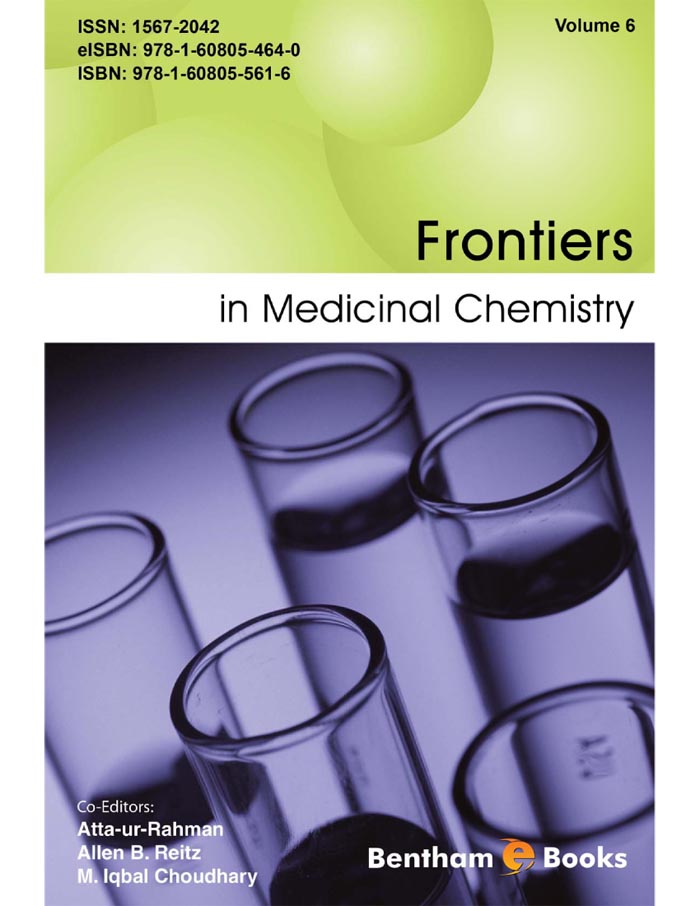Medicinal chemistry is an ever expanding discipline where new and exciting discoveries are made at the interface of chemistry and biology on a daily basis. The 6th volume of the Frontiers in Medicinal Chemistry contains 16 scholarly articles in six broad areas, contributed by some of the leading experts in the field of medicinal and pharmaceutical chemistry.
In the broad field of infectious diseases, five excellent contributions are compiled. The article contributed by Lori et al., reviews the most recent discoveries in the field of viral pathogenesis and the development of a new anti-retroviral class of compounds, termed as Antiviral-Hyper Activation Limiting Therapeutics (AV-HALTS) for the treatment of HIV-1. The use of viral CAPSID inhibitors for the treatment of human enterovirus infection and associated diseases is reviewed by Shih et al. Eugene Weinberg has contributed a very well written account of the use of lactoferrin protein in nutraceutical, preservative and pharmaceutical products.
The molecular basis of infection has been a topic of general interest since the last several decades. Lang et al., have reviewed the molecular targets of most common antibacterial agents. They linked the past experiences with the prospects of new drug discovery and development. Leishmaniasis is a parasitic disease, affecting a large number of people. Misra et al., have reviewed the area of drug development against leishmaniasis. This includes drugs which are based on new molecular targets against the parasite.
Cancer remains an important area of therapeutic research. Volume 6 of Frontiers in Medicinal Chemistry contains three well written articles which review various aspects of cancer chemotherapy. Based on the observations that antimicrobial peptides (AMPs) are differentially regulated in various cancers, such as oral squamous cell carcinomas, AMPs and their synthetic derivatives can be used as potential anticancer agents. This topic is reviewed lucidly by Roebke, et al.
Càrcer et al., in their review have discussed the development of novel inhibitors against cell cycle kinases, a key family of enzymes in cell proliferation. Another review in the field of oncology by Benjamin et al., focuses on newly discovered anti-tumor (primary bone tumors and bone metastases) activity of rapamycin and its derivatives. Rapamycin is a well known antifungal agent. In this review, the mTOR inhibitory activity of rapamycin derivatives is described, along with their primary mechanism of action as anti-tumour agents.
DNA-Based therapy of asthma is reviewed by Wang et al. Asthma is one of the most common health disorders globally, causing considerable morbidity. New approaches to the treatment of asthma by biologicals will certainly be of general interest.
Genetic predisposition to type-1 diabetes (T1D) is an area of considerable scientific interest. A number of marker molecules for T1D have been identified with some degree of confidence. Matteucci and Giampietro describe the results of their own investigations on various factors, genetic and epigenetic, which probably contribute in the development of T1D in certain families and population groups.
Efremov and colleagues have reviewed the role of lipophilicity in protein modeling for in silico drug designing. Molecular hydrophobicity (MHP) is an important property in drug ability assessment (Lipinski’s rule). This review narrates the applications of MHP-based techniques in a number of biologically important tasks.
Recent developments in mass spectrometry have contributed immensely in our understanding of biological processes. Hydrogen / deuterium exchange mass spectrometry, though based on an old concept, is now effectively employed in medicinal chemistry and drug development. Tsutsui and Wintrode have contributed an excellent review on hydrogen exchange mass spectrometry and its applications in structural biology, as well as in rational drug development.
The review by Shaikh et al., is concerned on the relevance of in silico studies in drug discovery and development, as well as in deducing the ADMET properties.
Indole alkaloids are important pharmacophores in various classes of drugs. Gupta et al., have contributed a review on bis- and tris-indole alkaloids, obtained from marine living resources. They have also reviewed the biological studies conducted so far on this important group of natural products.
Vaijayanti Kumar has reviewed the active research area of synthesis of nucleic acid and derivatives for therapeutic purposes. Structural modifications in nucleic acid mimics, which make them capable of binding with the RNA effectively, is the main focus of this well written article.
Pharmacological and clinical properties of PARP inhibitors [Poly (ADP-ribose) polymerase inhibitors] is reviewed by Lastra et al. The PARP family of enzymes is involved in a variety of physiological and pathological processes. PARP plays an important role in diseases such as stroke, cardiovascular, metabolic and inflammatory disorders. PARP inhibition is therefore an important strategy against various diseases, including viral infections.
The volume 6 of book series, “Frontiers in Medicinal Chemistry”, is expected to receive by the global fraternity of medicinal chemists and pharmaceutical researchers as it provides many excellent and comprehensive reviews in frontier areas of medicinal chemistry.
At the end, we acknowledge the dedicated effort and support of staff of the Bentham Science Publishers in connection with the timely processing of manuscripts for this volume of Frontiers in Medicinal Chemistry. Our special thanks go to Mr. Mahmood Alam and Ms. Qurat-ul-Ain in this connection.
ALLEN B. REITZ
Chemical Biology
Institute of Hepatitis and Virus Research
CEO, Fox C hase Chemical Diversity Center
Incorporation Doylestown, PA 18902
USA
ATTA-UR-RAHMAN, FRS
International Center for Chemical and
Biological Sciences, Karachi
Pakistan
M. IQBAL CHOUDHARY
International Center for Chemical and
Biological Sciences
Pakistan

